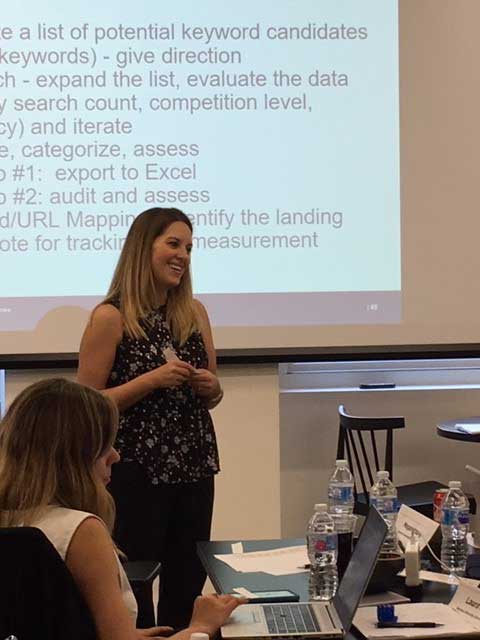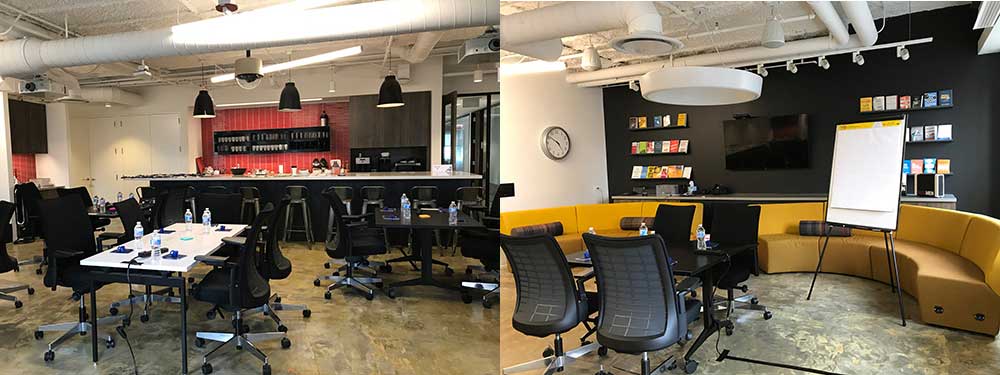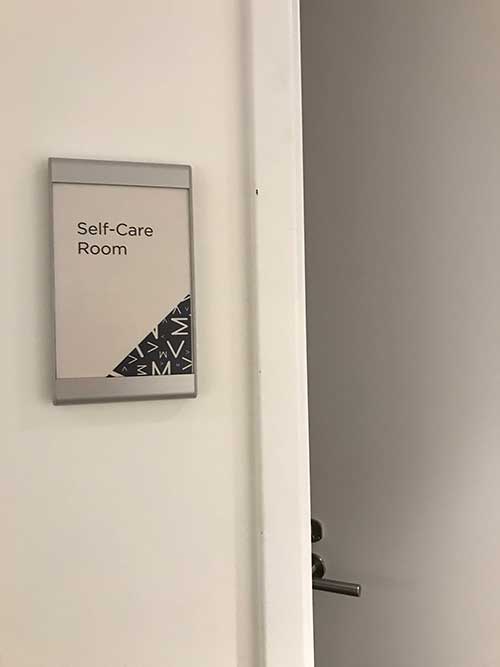 10 years ago, if you would’ve told me I’d be teaching SEO to adult learners in the marketing industry on stages and in front of classrooms, I wouldn’t have believed you. But here I am today, with 40 SEO presentations under my belt.
10 years ago, if you would’ve told me I’d be teaching SEO to adult learners in the marketing industry on stages and in front of classrooms, I wouldn’t have believed you. But here I am today, with 40 SEO presentations under my belt.
I’ve led 45-minute SEO workshops. 2-hour SEO seminars. A 4-hour SEO course. For a few years in a row I co-taught full-day SEO bootcamps. I felt pretty confident I had conquered every time length and format of presenting on SEO.
Until this year. I was offered the incredible opportunity to put together and lead a 2-day SEO training on behalf of AMA (American Marketing Association) at their headquarters in Chicago.
2 days…8 hours each day…teaching solo…in front of a room full of 25 marketers. Gulp.
But I said yes, crossed my fingers, and said a prayer I wouldn’t embarrass myself.
Fast forward to today. Two weeks ago I led this 2-day training. What…an….experience.
I understand many professionals can put together and lead an event like this in their sleep.
This is not the case for me, and if it’s not the case for you either, then read on. I poured a lot of effort and forethought to shaping and presenting a training that was the best it could be, and I wanted to share a few takeaways and behind-the-scenes notes.
5 Lessons Learned From Leading a 2-Day, 14-hour SEO Training
Lesson 1: Fake It Til You Make It.
I am a big advocate of “fake it til you make it.” It’s the entire reason I have been able to survive (and mostly thrive) for 10 years running a business. When presented with an opportunity to face a new challenge, you accept first and figure out how to do it after (within reason of course).
I wish I felt as cool as I portrayed on the outside when I was really shaking in my boots.
But in the end, I persevered. I am a professional damn it. I am great at my craft and worthy of getting paid well.
It’s funny how stepping outside of your comfort zone is never really something you get used to.
Lesson 2: Call in Reinforcements to Learn How to Sustain Energy
One of the most important things I did to prep for this event was to hire a breathing coach. I know, I know. WTH is a breathing coach? Let me back up.
There is no degree in SEO. No college course. No official industry-accepted certification.
When you do SEO, nothing is certain, nothing is guaranteed, nothing stays the same for long. Do you know what that means? You can’t ever stay confident for long and you can’t ever comfortably settle. I started out as a salesperson turned copywriter turned SEO professional from the SEO school of hard knocks (see Lesson 1 above). So it is no wonder that for years, I felt like such an imposter giving SEO talks.
But I kept speaking anyway. It helped that I loved speaking on SEO, I truly was passionate about the topic, and I’m a fast talker naturally which helped the presentation time speed right by. Thankfully, I’ve gotten overwhelmingly positive feedback and comments.
Except one time. I had someone from the audience pull me aside and tell me that I needed to slow down. And breathe. That I was rushing through the content and it was obvious that it was due to a lack of confidence. Welp. That sucked but I needed to hear it.
 Shortly after that, I met an acting coach in a business mastery program. A woman who coached singers, actors, and performers. I told her about my speaking struggles and she said that helping people “breathe, pace, and confidently talk and present” was exactly what she could help address.
Shortly after that, I met an acting coach in a business mastery program. A woman who coached singers, actors, and performers. I told her about my speaking struggles and she said that helping people “breathe, pace, and confidently talk and present” was exactly what she could help address.
I’ve virtually worked with this coach, Michelle Wolf, twice in the past few years. She’s amazing. She helped me go from feeling depleted after a 45-minute talk (like I had just run a marathon) to feeling sustained energy and confidence over my 2-day event.
Lesson 3: A Run of Show is Critical
Putting together the outline for a 2-day event was simple. Putting together the actual slide-by-slide presentation for 14 hours of content? Not so simple. Thankfully, a very smart friend (shout out to Brandy!) sat down with me and introduced me to a document called a Run of Show, which ended up being a critical piece to the success of leading a 2-day event solo.
Typically used for live show TV productions, a Run of Show is a tool that lays out the timing, program, and content for each moment of an event.
For weeks I kept “layering” in details into my Run of Show:
- I started with the outline of each day that I had to submit to the organizers about 10 months ahead of the event
- Then I added in the start time, end time, breaks, and lunch
- I added set-up details, from the time I needed to leave my hotel and walk over, to what time AV would set up, to what worksheets needed to be at each attendee’s desk upon arrival
- I added in interactive details parts: completing worksheets, Q&A, sharing takeaways, hands-on activities, documentation and planning, etc.
- Then I factored in the timing for each chunk of the day. From introductions around the room to how long it would take to go through housekeeping to how long worksheets would take to Q&A and content on the slides, etc.
- I added in notes to myself in a small column – cue the YouTube coffee shop background music, parts of the day when I could slip away for my breaks (so I was available to students for their breaks), questions that would generate discussions, note to refill my water, and more
- Then I would tweak, tweak, tweak to my little heart’s content (up until the morning of!)
The end result was this breathtaking, gorgeous, organized document detailing by the minute what needed to happen. I was able to adjust on the fly if I was (inevitably) running over. I built in space and time appropriately and was confident at the front of that classroom from start to finish. Speaking of the classroom…..
Lesson 4: Provide Feedback to Help Those Who Come After You
Have you ever been upgraded to first class, and then the next time you are back in the normal coach section you’re disappointed because now you know how good it was at one time?
I’m afraid that’s me. Spoiled now beyond belief. The venue I spoke at was AMA’s Training Center, which is part of their very cool new office. We hit the max number of attendees for the room’s capacity. This might’ve made space somewhat tight, except for the fact that the room was designed brilliantly. From carpeted auditorium seating on the left side of the room (complete with bean bags) to a large standing-desk height counter in the back of the room to a cozy den with couches on the right (complete with shelves full of popular marketing books) to the typical tables in front of the screens, the room felt cozy and creative. And very conducive to helping a group of marketers learn for a long period of time.


What else contributes to a first-class speaking arrangement? Feedback over time given to the organizer from past speakers, employees, and attendees that lent the ultimate experience speaking:
 a padded chefs mat to stand on as I was in heels for 8 hours/day? Check
a padded chefs mat to stand on as I was in heels for 8 hours/day? Check- a designated “self-care room” for this introvert to hide out in during breaks and catch her breath? Check Check
- delicious food, abundant coffee, and ample tea with honey to soothe a throat from speaking all day? Check Check Check
- An AV team that was super attentive, visible, and helpful? Check Check Check Check
Now I know why speakers have riders.
Lesson 5: If the Content Doesn’t Inspire Me, It Won’t Inspire Anyone Else
I had 10 months to prepare the content for the presentation. Being a perfectionist, of course that didn’t stop me from sweating the deadline in the days ahead of my presentation due date. The content, and subject matter itself, I knew. But it was the extra time I had to go deeper into topics that was new for me. In a 45-minute presentation on SEO, keyword research is maybe 15 minutes. In my 2-day, it was over 2 hours. And it was glorious. We had time to not only talk about tools, but to get hands-on with them.
I broke the training out into multiple sections: SEO fundamentals and Modern Search Behavior and Trends, Keyword Research, SERPS Assessments, Analytics Part 1, Competitive Auditing, Analytics Part 2, Technical SEO, On-Page SEO and Content Marketing, Off-Page SEO and Social, and Industry Nuances.
Putting together the content was intimidating but in the end, not too bad. The easy part was that the event was advertised as Intermediate SEO, so I knew the participants would all have working knowledge of SEO fundamentals.
For the most part, I was pretty happy with my content. Except for the piece on Technical SEO. Technical SEO is my Kryptonite. I’ve been doing SEO for about 10 years now, but because I started as a copywriter and not a developer, I’ve always felt gun shy about teaching on Technical SEO. Enter a brilliant idea from a colleague to introduce the section with a video. And not just any video. A Rand Fishkin, Whiteboard Friday video. If there’s anything that will get me excited about jumping into a Technical SEO lesson, it’s Rand.
In the end, there’s one thing I know for sure.
Overall, the 2-day was a huge success. It went so well I was immediately signed on to conduct two more additional trainings in the next six months. Personally, it was a career milestone event for me.
Here’s the last thing I can say with certainty. The next time I have to put together a short/normal presentation, it’s going to be a struggle. Having 2 full days to dive deep and get hands-on has ruined me. I guess we’ll see!
SEO |